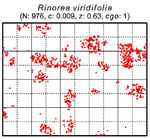Abstract
Aim The relationship between the proportion of sites occupied by a species and the area of a site [occupancy–area relationship (OAR)] offers key information for biodiversity management and has long fascinated ecologists. We quantified the variation in OAR for 3,157 woody species in 17 forest plots worldwide and tested the relative importance of environment and species traits for explaining this variation and evaluated overall model predictive ability.
Location Global.
Time period Early 21st century.
Major taxa studied Woody plants.
Methods We used mixed-effect regression to examine the observed shape of the OAR (its “slope”) against species-specific and plot-wide predictors: coarse-grain occupancy, tree size, plot species richness, energy availability and topographic complexity.
Results We found large variation in OAR slopes, and the variation was strongest among species within plots. The OAR slopes showed a latitudinal trend and were steeper near the equator. As predicted, coarse-grain occupancy and tree size negatively affected OAR slopes, whereas species richness had a positive effect and explained most of the variance between plots. Although hypothesized directionalities were broadly confirmed, traits and environment had relatively limited overall predictive power.
Main conclusions These results document the variation of the OAR for 3,157 species at near-global extent. We found a latitudinal gradient in OAR slopes and confirmed key hypothesized predictors. But at this global extent and over the large set of species analysed, the remaining unexplained variation in OAR slopes was substantial. Nevertheless, this large-scale empirical analysis of the OAR offers an initial step towards a more general use of OARs for the fine-scale prediction of species distributions and abundance.
